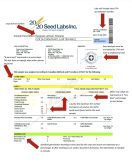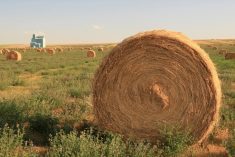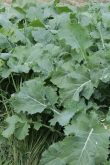Rows and rows of white metal cabinets resembling refrigerators line the basement of the Agriculture and Agri-Food Canada (AAFC) Research Centre in Quebec City.
In fact, they are plant growth chambers that contain bright grow lights and potted alfalfa plants at different stages of maturity. In another area of the building there is a large walk-in freezer full of other potted alfalfa plants that have been cut to stubble height, waiting to be frozen. This is the heart of the Quebec alfalfa breeding program to create new varieties of cold-tolerant alfalfa.
Read Also

Why post-drought pasture management matters for beef farmers
Pasture management is always important, but it is especially important following a drought. During these challenging periods, pastures may suffer…
Dr. Annick Bertrand, a plant physiologist at Quebec, is part of a multidisciplinary team to develop more winter-hardy alfalfa varieties.
“All across Canada forage producers and livestock grazers experience winter kill in their alfalfa fields. Beef producers — especially in the northwestern Prairies — require alfalfa cultivars with greater winter hardiness and late-season yield to extend the grazing season and increase the hay supply,” says Bertrand.
In years past, plant breeders would develop new varieties by selecting genotypes that survived winters within their field nurseries.
“This is a very costly and highly unpredictable process that requires trials at multiple sites over many years to identify genotypes of superior potential for winter hardiness,” says Bertrand. “We needed to find ways to speed up the selection process to incorporate freezing tolerance into cultivars with high agronomic value.”
They developed an indoor selection method to identify plants that are more cold tolerant, which sped up the selection process. To do this, they grow thousands of single alfalfa plants in a pot in growth chambers. When plants are mature, they fast-track winter dormancy by reducing day length and lowering the temperature. These potted plants are then placed in a large walk-in freezer and, within two days, the temperatures are gradually reduced to -26 C or so.
After this, the plants are gradually warmed and put back in the growth chambers. They are then able to determine which plants are still alive. They cross-pollinate each flower of the surviving plants for seed set and later harvest the seeds of each plant. A pool of those seeds constitutes a new alfalfa population that is then planted in a pot and again grown out in a growth chamber to start the whole process over again. This way they can get two or more growing seasons each year.
“We have been able to increase the freezing tolerance from -20 C to -26 C in cultivar Apica after six indoor cycles of selection. In comparison, one outdoor cycle of selection for winter survival takes from one to three years depending on the occurrence of a test winter,” says Bertrand. A test winter must be cold enough to kill between 20 and 50 per cent of the plants, she explains.
“I am particularly interested in the chemistry of plants and I have found that there is an increase in sugar and certain amino acids that could partly explain why some selected plants are more cold tolerant that others,” says Bertrand.

These contrasting populations have also been used by Dr. Solen Rocher, a molecular biologist at Quebec, to identify molecular markers that are associated with freezing tolerance. These markers could be used as new genetic tools to accelerate breeding for cold-tolerant alfalfa.
“It is a real challenge to search for molecular markers in alfalfa,” says Rocher. “Not only is alfalfa heterozygous, but it is also polyploid, which further complicates the picture. Alfalfa itself is a vast reservoir of genetic diversity but is very resistant to giving it up.”
Fortunately, high-throughput sequencing tools are now accessible, Rocher adds. Breeders will be able to use molecular selection tools to predict the performance of new experimental lines of early generations, accelerating the development rate of new crops.
Tweaking plant-breeding techniques
Cold hardiness and increased plant dormancy have gone hand-in-hand in the development of alfalfa varieties for the Prairies. The majority of the Prairie farming area is in dormancy regions one and two, with cold winters and short growing seasons.
“As one travels from south to north, late summer and fall day length decreases at a more and more rapid rate, bringing on dormancy and reduced growth earlier, effectively reducing days of active growth. This particularly limits alfalfa’s second growth, reduces overall yield and quality of grass- legume mixtures and may reduce the competitive ability of the legume relative to grass,” says Dr. Vern Baron, a collaborator from Lacombe, Alta.
Traditionally, breeders have used yellow-flowered Falcata sub-species to attain both dormancy and hardiness, but growing these types may result in a single cut or graze in areas with rapidly declining day length. Also, they may not be as hardy as previously thought in the moister areas of the Prairies. It is possible to select alfalfa genotypes with high autumn yield and acceptable winter hardiness by crossing populations from adjacent higher and lower dormancy zones and then selecting the most winter hardy within a specific region.
However, to speed up the process, the Quebec research team slightly modified their selection method for cold tolerance to include a step that mimics fall conditions. By selecting genotypes with both enhanced winter hardiness and reduced fall dormancy, they improved late-season alfalfa productivity for grazing in plants suitable for dormancy in regions one and two.
The new Quebec breeding techniques may allow highly productive genetic material to move from dormancy region four or five to dormancy region one and two, says Baron. By selecting for reduced dormancy in hardy material identified in dormancy region one, the techniques can improve freezing tolerance or increase regrowth, he adds.
Plant breeders were able to produce fewer dormant plants from material sourced from Peace and Yellowhead genetics, after one recurrent selection cycle. These plant populations were tested in the field at four locations across Canada: Lacombe, Alta.; Swift Current, Sask.; Normandin, Que.; and Quebec City. A Yellowhead population had higher fall regrowth at all locations, while retaining the same level of winter hardiness.
The Yellowhead and Peace populations obtained after three selection cycles are being tested in the field to see whether they’ve made gains in fall productivity with- out losing freezing tolerance. Baron says they’ll also test the new types under grazing.
The long road ahead for a new variety
“Even though we greatly accelerated the process of selection of winter-hardy and low-dormant alfalfa plants with our method of recurrent selection under con- trolled conditions, there is still a very long road ahead to obtain certified seed of a new alfalfa variety available for sale to the farmers,” says Dr. Annie Claessens, plant breeder at Quebec.
It takes between three to 10 years of cross-breeding individual potted alfalfa plants to develop a new population, Claessens says. Then the seed from this final selection needs to be increased in the greenhouse to get the eight grams of breeder seed needed to move to the seed multiplication in the field.
From there, the seeds are increased in cages in Idaho, until breeders have 0.8 to one kilogram of seeds. Next, they carry out field trials to evaluate the agronomic performance of the new population. Provincial trials no longer exist, so each breeder carries out the trial, which takes at least eight site-years.
“If this population performs better than the checks for the trait under selection and better or as well as the checks for the other agronomic traits, the rest of the seed is sent to the AAFC Indian Head Research Centre in Saskatchewan,” says Claessens. “They grow the seed to eventually produce about 50 kg of breeder seed. This takes three to five years and it has to be grown in clean, isolated plots since there can be no contaminants or weed seeds in the final breeder’s seed.”
Meanwhile, Claessens characterizes the new variety, producing the information needed to write a detailed description and to complete the forms for the call for licensing proposals from the Canadian Seed Trade Association companies. A seed company is chosen to distribute the new variety and AAFC completes the paperwork to register it with the Canadian Food Inspection Agency. The seed company then contracts specific seed growers to multiply the seed. That seed is later distributed to other seed growers to multiply into certified seed, which is finally sold to farmers.
It takes about six or seven years from the time the plant breeders have selected the population they want to multiply to when that seed is available to producers.
There is no shortage of challenges for Canadian forage specialists. Beef and dairy producers not only need long-lasting and high-yielding forages, they also need high-quality forages to reduce the costs and the sustainability of their production. Quebec research teams have demonstrated that ruminants fed with high-energy forages have better nitrogen-use efficiency that translates into less nitrogen lost to the environment. Furthermore, in dairy cows, high-energy forages also lead to greater milk and milk fat productions.
But breeding for high energy in forages is difficult because sugar concentration in the plant is strongly influenced by environmental conditions and varies between sunny and cloudy days, morning and afternoon cut, as well as plant development stages.
Since the sugar concentration in the stems is less prone to daily fluctuations, breeders are using stem sugar content as a reliable selection trait. They were able to develop an alfalfa population with energy content 10 per cent higher than in the initial population. The trait was shown to be stable regardless of the developmental stage and cutting date.
Alfalfa populations selected for high-sugar concentration in stems will be evaluated in the field at three sites (Lethbridge, Alta.; Normandin, Que.; and Quebec City) over the next couple of years. It will also serve as germplasm to develop new high-energy alfalfa cultivars for beef and milk production.
Yes,plant breeding to improve wintering abilities and to increase nutritional benefits for Canadian livestock and forage producers is a very long and tedious process. But it’s worthwhile as these new varieties will be adapted to our climatic conditions and are developed to meet the challenges facing our producers.
















